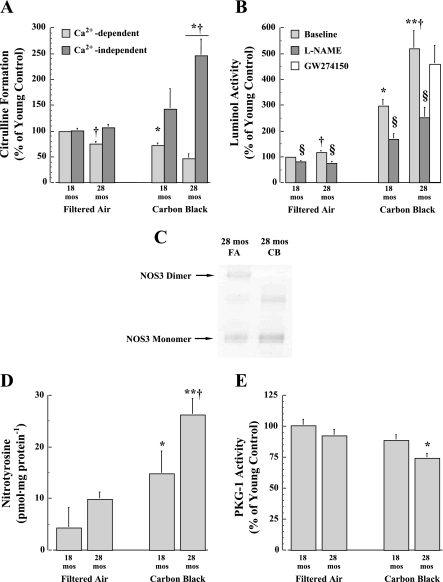Fig. 4.
A: Ca2+-dependent and Ca2+-independent NOS activity as measured by the rate of citrulline formation from heart tissue samples obtained from 18- and 28-mo-old mice exposed to either FA or CB for 4 days each for 3 h. Left: nitric oxide synthase (NOS) uncoupling was evident by a decline in Ca2+-dependent NOS activity (NOS3 and NOS1) in both age groups following CB exposure. Right: Ca2+-independent activity (NOS2) was upregulated in only the 28-mo-old mice exposed to CB. B: luminol activity at baseline and during NG-nitro-l-arginine methyl ester (l-NAME) coincubation indicates an increase in reactive oxygen species (ROS) generation with CB exposure in both age groups, and the origin of ROS formation is associated with an increase in NOS activity. The coincubation with the selective NOS2 inhibitor GW274150 was not significantly (P > 0.05) different from baseline. C: representative blot comparing NOS3 dimer and monomer from isolated cardiac myocytes from 28-mo-old mice exposed to either FA or CB demonstrating a reduction of NOS3 dimer with CB exposure. D: increase in nitrotyrosine concentration as an indicator of peroxynitrite (ONOO− species) formation further suggest that greater ROS generation occurs in hearts of 28-mo-old animals following CB exposure. E: significant reduction in PKG activity in 28-mo-old mice exposed to FA or CB indicates lower second messenger activation by NOS or natriuretic peptide release (n = 10 mice per age group). *P < 0.05 and **P < 0.01, CB vs. FA exposure; †P < 0.05, 28 mo vs. 18 mo; §P < 0.05, l-NAME vs. baseline.

